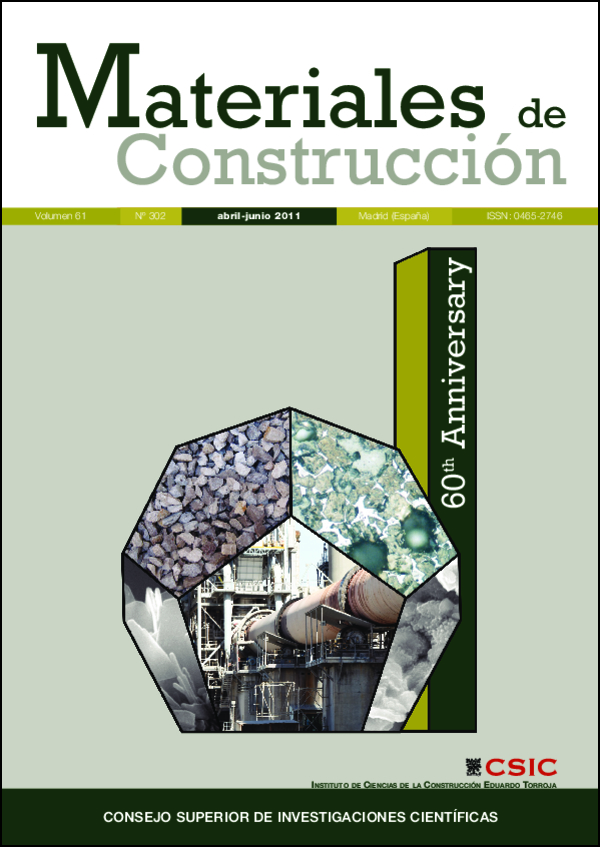Lightweight self-compacting concrete reinforced with fibres for slab rehabilitation
DOI:
https://doi.org/10.3989/mc.2011.55509Keywords:
viscosity modifier admixture, lightweight concrete, self-compacting concrete, fibres, rehabilitationAbstract
The slabs of some buildings in Barcelona are formed by unidirectional beams, with a ceramic arch in between, which are filled with broken pottery or construction waste. These structures often present problems such as displacement of the tiles arranged over it due to the lack of stiffness of the filling material. This supposes a risk to the user and could also cause durability problems. In order to rehabilitate it, a lightweight self-compacting concrete reinforced with fibres (HLACF) has been designed to be used as a filling material, improving the stiffness of the structure. This paper presents a structural analysis of a standard case and the results of an experimental campaign. The concrete showed a density of 1665 kg/m3, a slump flow of 605 mm and a compressive strength of 22.3 MPa, at 28 days. These results are in agreement with the requirements, overcoming common lightweight concrete segregation problems.
Downloads
References
(1) Rasell Calamina, J.: “La construcció en l’arquitectura de Barcelona a finals del segle XVIII”, Tesis doctoral dirigida por Pere Here, Barcelona, UPC, 1996.
(2) Paricio Casademunt, A.: “Analisi del sistema constructiu a base de murs de carrega, utilitzats en la formació de l’ Eixample de Barcelona”, Tesis doctoral dirigida por Fructuoso Maña. Departament de Construccions Arquitectòniques I. Barcelona, UPC, 1999.
(3) Haist, M.; Müller, H. S.: “Optimization of the pumpability of self-compacting lightweight concrete”, The Second North American Conference on the Design and Use of Self-Consolidating Concrete, Chicago, s.n., 2005.
(4) Tasdemir, M. A.; Atahan, H. N.; Gokalp, I.; Yerlikaya, M.: “Comparison of workability and mechanical properties of normal and lightweight SCCS with and without steel fibers”, The Third North American Conference on the Design and Use of Self-Consolidating Concrete, Chicago, s.n., 2008.
(5) Aguado, A.; Masó, D.; Klein, N. S.: “Hormigón autocompactante ligero con fibras estructurales para rehabilitación de forjados de edifícios”, Patente, nº de solicitud P 2009 02445.
(6) BOE, 23/10/2007. Documento básico SE-AE Acciones en la edificación, 2007.
(7) Pujadas, P.: “Durabilidad del hormigón con fibras de polipropileno”, Tesina de Especialidad (directores: Aguado de Cea, A.; Vandewalle, M.), Barcelona, UPC, 2008.
(8) Collins, M. P.; Mitchell, D.: “Prestressed Concrete Basics”, Ontário, Canadian Prestressed Institute, 1987.
(9) RILEM. “Tests and Design Methods for Steel Fibre Reinforced Concrete, S.L.”, Materials and Structures, 2003, vol. 36, 262, pp. 560-567. http://dx.doi.org/10.1617/14007
(10) Barros, J. A. O.; Cunha, V. M. C. F.; Ribeiro, A. F.; Antunes, J. A. B.: “Post-cracking behavior of steel fibre reinforced concrete”, Materials and Structures. 2005, vol. 38, pp. 47-56. http://dx.doi.org/10.1007/BF02480574
(11) De la Fuente, A.: “Análisis no lineal y comportamiento en servicio y rotura de secciones construidas evolutivamente sometidas a flexocompresión recta”, Tesina de Especialidad (directores: Aguado de Cea, A.; Molins Borrell, C.). Barcelona, UPC, 2007.
(12) De la Fuente, A.; Aguado, A.; Molins, C.: “Modelo no lineal para el análisis de secciones prefabricadas construidas evolutivamente”, Hormigón y Acero, 2008, vol. 57, 247, pp. 69-87.
(13) Revuelta, D.; Barona, A.; Navarro, D.: “Measurement of properties and of the resistance to segregation in heavyweight, selfcompacting barite concrete”, Mater. Construcc., 2009, vol. 59, 295, pp. 31-44. http://dx.doi.org/10.3989/mc.2009.43907
(14) Domone, P. L.: “Self-compacting concrete: an analysis of 11 years of case studies, S.L.”, Cement and Concrete Composites, 28, 2006, pp. 197-2008. http://dx.doi.org/10.1016/j.cemconcomp.2005.10.003
(15) AENOR, Asociación Española de Normalización y Certificación. UNE-EN 12350-6, Ensayos de hormigón fresco. Parte 6: Determinación de la densidad. Madrid, s.n., 2006.
(16) UNE 83361 - Hormigón autocompactante - Caracterización de la fluidez - Ensayo del escurrimiento, Madrid, s.n., 2007.
(17) UNE 83362 - Hormigón autocompactante - Caracterización de la fluidez en presencia de barras - Ensayo del escurrimiento con el anillo japonés, Madrid, s.n., 2007.
(18) UNE-EN 12350-2 - Ensayos de hormigón fresco. Parte 2: Determinación del contenido de aire del hormigón fresco. Métodos de presión, Madrid, s.n., 2006.
(19) UNE-EN 12390-7 - Ensayos de hormigón endurecido. Parte 7: densidad del hormigón endurecido, Madrid, s.n., 2001.
(20) UNE-EN 12390-3 - Ensayos de hormigón endurecido. Parte 3: Determinación de la resistencia a compresión de probetas, Madrid, s.n., 2003.
(21) UNE 83515 - Hormigones con fibras. Determinación de la resistencia a fisuración, tenacidad y resistencia residual a tracción. Ensayo Barcelona, Madrid, s.n., 2008.
(22) Molins, C.; Aguado A.; Saludes S.: “Double Punch Test to control the tensile properties of FRC (Barcelona test)”, Rev. Materials and Structures (RILEM), vol. 42, nº 4, mayo de 2009, pp. 415-425.
(23) Turmo, J.; Banthia, N.; Gettu, R.; Barragán, B.: “Study of the shear behaviour of fibre reinforced concrete beams”, Mater. Construcc., vol. 58, 292, 2008, pp. 5-13.
(24) Comisión Permanente del Hormigón. Instrucción del hormigón estructural EHE-08, Ministerio de Fomento, diciembre de 2008.
Downloads
Published
How to Cite
Issue
Section
License
Copyright (c) 2011 Consejo Superior de Investigaciones Científicas (CSIC)

This work is licensed under a Creative Commons Attribution 4.0 International License.
© CSIC. Manuscripts published in both the print and online versions of this journal are the property of the Consejo Superior de Investigaciones Científicas, and quoting this source is a requirement for any partial or full reproduction.
All contents of this electronic edition, except where otherwise noted, are distributed under a Creative Commons Attribution 4.0 International (CC BY 4.0) licence. You may read here the basic information and the legal text of the licence. The indication of the CC BY 4.0 licence must be expressly stated in this way when necessary.
Self-archiving in repositories, personal webpages or similar, of any version other than the final version of the work produced by the publisher, is not allowed.
















